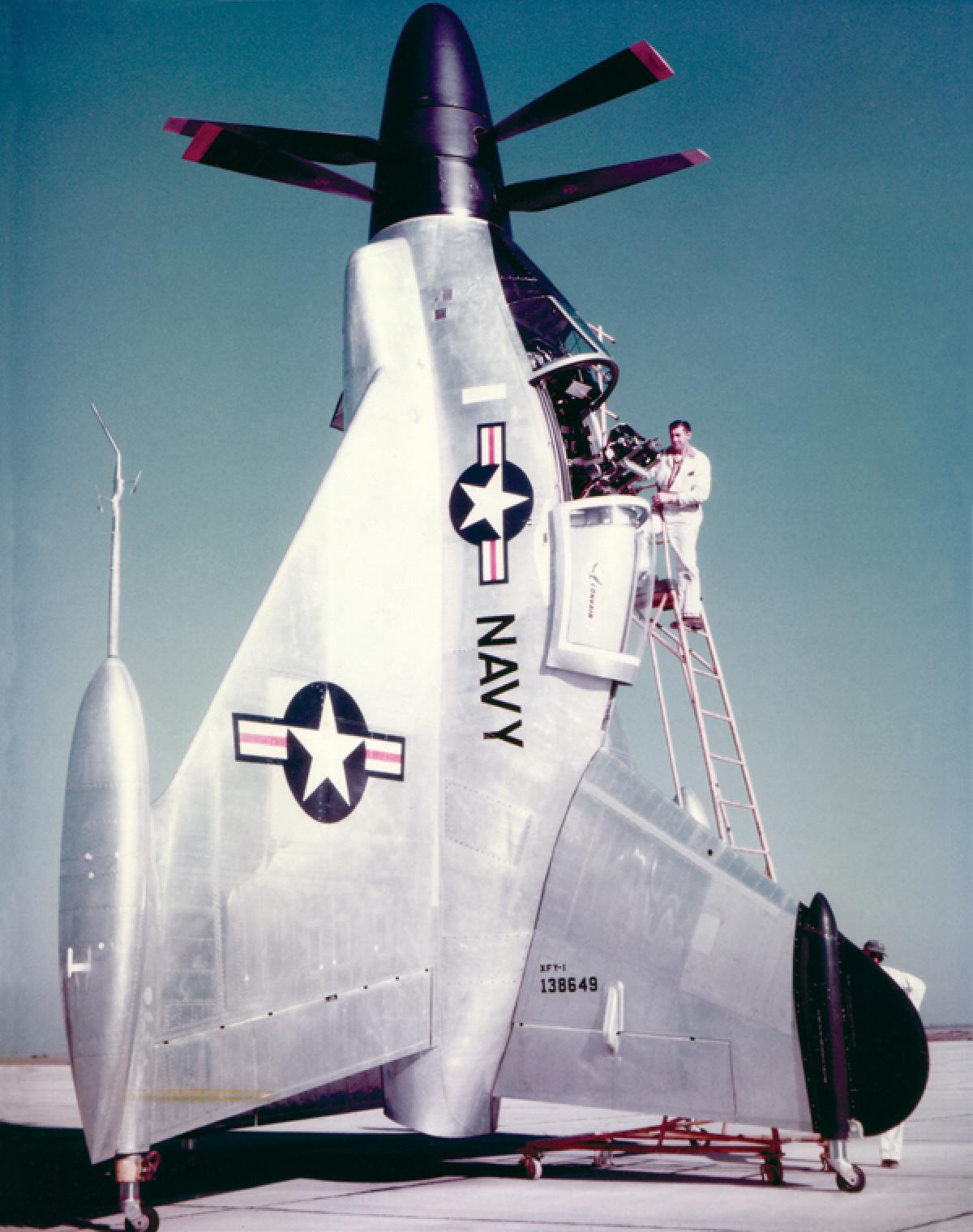While Lockheed was developing the XFV-1 vertical-takeoff-and-landing (VTOL) fighter, Convair was working on a competitive design—the XFY-1, given the unofficial moniker “Pogo.”1 Both aircraft were “tail-sitters”—intended to operate in the defensive fighter role from small platforms on warships and possibly on merchant ships. They owed their origins to the German “thrust-wing fighter” design of World War II.
The Convair prototype had a modified delta-wing planform complemented by two large, vertical tail surfaces. The ventral tail could be jettisoned to permit a conventional emergency, wing-supported landing by the plane. For VTOL operations the aircraft—in tail-sitting vertical attitude—sat on castering wheels fitted to all four “wingtips.” The pilot’s seat was mounted on gimbals and could tilt 45 degrees when the fighter was vertical.
The Allison YT40-A-6 turboprop engine of the XFY-1 turned two contra-rotating, three-blade propellers, the same configuration as the XFV-1. The engine’s estimated 5,850 horsepower was a limiting factor in the aircraft’s trials. Production craft would have the more powerful XT-40-A-16 engine. After takeoff, both planes would transition to horizontal flight to serve as fighter-interceptors. To land vertically they would hang on their propellers to transition to the vertical-landing configuration.
Planned production FY-2 fighters were to be armed with four 20-mm cannon or 48 2.75-inch unguided rockets in wing pods.
Tethered flight tests of the XFY-1 began on 19 April 1954, in the 184-foot-high airship hangar at Moffett Field, California. A specially designed cable safety mechanism was attached to the nose of the aircraft and secured to a winch on the hangar ceiling. If in attempting vertical flight the plane lost power or control, it could be saved from crashing. Additional cables were fastened to each of the four wing surfaces to provide stability in the event that control was lost. The prototype flew some 60 hours in the tethered mode.
The first of three planned prototype XFY-1 aircraft actually flew—untethered—on 1 August 1954, rising to 20 feet, with Convair test pilot James F. “Skeets” Coleman, a former Marine Corps aviator, at the controls. The plane’s initial transition from vertical to horizontal flight was accomplished on 2 November 1954.2 Coleman commented that the XFY-1 was “more maneuverable and responds faster than any plane I’ve ever flown.”3
A variety of problems and challenges caused delays in the program and the interval between first flight and transitional flight. The XFY-1 was demanding to land and had severe control difficulties, especially when in hover mode, as well as other problems that were revealed in flight tests. After some 40 hours of untethered flight, the program was formally abandoned in August 1955, although flight tests continued into November 1956. Coleman received the coveted Harmon Trophy in 1955 for his XFY-1 flights, which were officially cited as the first successful VTOL flights in history, with the aircraft taking off vertically, transitioning to forward flight, and then making a vertical landing.4
The Pogo got wide attention when the main character—a veteran Navy pilot—in the popular comic strip “Buz Sawyer” flew an XFY-1. Cartoonist Roy Crane had his pilot-hero flight test the fighter—when he wasn’t fighting foreign spies and stopping surprise attacks against the United States.
Only one of the three XFY-1 prototypes was completed; it is in the collection of the National Air and Space Museum. Thus ended another interesting but impractical aviation development effort. Aviation enthusiast Bill Yenne included the two tail-sitters in his book The World’s Worst Aircraft, even providing a photo of the XFY-1 as the book’s frontispiece. His derision of the tail-sitters was to some degree warranted, but without such efforts at innovative and unusual approaches to flight, none of history’s great aviation advances could have been accomplished.5
Editor’s note: Mr. Polmar described the Lockheed tail-sitting XFV-1 prototype in the June 2013 issue of Naval History.
1. John Wegg, General Dynamics Aircraft and their Predecessors (Annapolis, MD: Naval Institute Press, 1990), 207. The most comprehensive journal articles on these aircraft are Bill Gunston, “U.S. Navy prop-hangers,” Aeroplane Monthly (October 1974), 890–98, and Francis J. Allen, “Bolt Upright,” Air Enthusiast (January/February 2007), 13–20.
2. At the time, Coleman was a lieutenant colonel in the Marine Corps Reserve.
3. “Convair’s Pogo Pioneered True Vertical Flight,” General Dynamics World (July 1983), 4.
4. The award was established in 1926 by Clifford B. Harmon, a wealthy aviator and aviation enthusiast. In addition to the outstanding aviator of the year the Harmon Trophy also is awarded annually to the outstanding aviatrix and aeronaut.
5. Bill Yenne, The World’s Worst Aircraft (Greenwich, CT: Dorset Press, 1990), 128–35.



